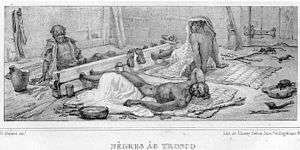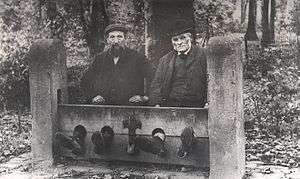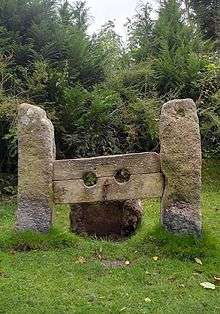Stocks

Stocks are devices that were used internationally, in medieval, Renaissance and colonial American times as a form of physical punishment involving public humiliation. The stocks partially immobilized its victims and they were often exposed in a public place such as the site of a market to the scorn of those who passed by. This scorn was commonly represented by throwing rotten food at the victim.
Form and application
The stocks are similar to the pillory and the pranger, as each consists of large, hinged, wooden boards; the difference, however, is that when a person is placed in the stocks, their feet are locked in place, sometimes their hands or head may have been chained also.
With stocks, boards are placed around the ankles and the wrists in some cases, whereas in the pillory they are placed around the arms and neck and fixed to a pole, and the victim stands. However, the terms can be confused, and many people refer to the pillory as the stocks.
The victims feet were usually bare, this caused heightened humiliation.
Since stocks served an outdoor public form of punishment its victims were subjected to the daily and nightly weather. As a consequence it was not uncommon for people kept in stocks over several days to die from exposure.
The practice of using stocks continues to be cited as an example of torture and cruel and unusual punishment. Victims may be insulted, kicked, tickled, spat on, or subjected to other inhumane acts at the discretion of passersby.
Historical uses
One of the earliest references to the stocks in literature appears in the Bible. Paul and Silas, disciples of Jesus, were arrested. Their treatment by their jailer was detailed in the Book of Acts: "Having received such a charge, he put them into the inner prison and fastened their feet in the stocks."[1] The Old Testament's book of Job also describes the stocks, referring to God: "He puts my feet in the stocks, he watches all my paths."[2]
The stocks were also popular among civil authorities from medieval to early modern times, and have been used as punishment for military deserters or for dereliction of military duty. In the stocks, an offender's hands and head, or sometimes their ankles, would be placed and locked through two or three holes in the center of a board. Offenders were forced to carry out their punishments in the rain, during the heat of summer, or in freezing weather, and would generally receive only bread and water, plus anything brought by their friends.
The stocks were popular during the Colonial days in America. Public punishment in the stocks was a common occurrence from around 1500 until at least 1748.[3] The stocks were especially popular among the early American Puritans, who frequently employed the stocks for punishing the "lower class." [4][5]
In the American colonies, the stocks were also used, not only for punishment, but as a means of restraining individuals awaiting trial.[6]
The offender would be exposed to whatever treatment those who passed by could imagine. This could include tickling of the feet. As noted by the New York Times in an article dated November 13, 1887, "Gone, too, are the parish stocks, in which offenders against public morality formerly sat imprisoned, with their legs held fast beneath a heavy wooden yoke, while sundry small but fiendish boys improved the occasion by deliberately pulling off their shoes and tickling the soles of their defenseless feet."[7]

England's second Statute of Labourers prescribed the use of the stocks for "unruly artisans" in 1350, and required that every town and village erect a set of stocks. Sources indicate that the stocks were used in England for over 500 years and have never been formally abolished.[8]
Finger pillories often went by the name of "finger stocks". Public stocks were typically positioned in the most public place available, as public humiliation was a critical aspect of such punishment. Typically, a person condemned to the stocks was subjected to a variety of abuses, ranging from having refuse thrown at them, tickling to paddling, whipping of the unprotected feet (bastinado).
Their last recorded use in the United Kingdom was in 1872 at either Adpar, Newcastle Emlyn, west Wales [9] or Newbury, Berkshire, England (11 June).[10]
In Toronto, Ontario, Canada, court records from 1811 required the building of a set of stocks for punishment.[11]
The Spanish conquistadores introduced stocks as a popular form of punishment and humiliation against those who impeded the consolidation of their settlements in the new world. They were still used in the 19th century in Latin America to punish indigenous miners in many countries for rebelling against their bosses.
Modern usage
United States
On August 5, 1989, the Dermott, Arkansas (U.S.A.) City Council passed an ordinance prohibiting children from breaking curfew, by providing for a sentence of 30 days in jail with two days in an open-air public stockade for their parents.[12] The ordinance was modified two weeks later to delete the reference to the stockade, as the term was undefined, the town did not have a stockade, and no funds were allocated to build one.[13]
Whether punishment by placement in the stocks may be allowed under the American criminal justice system, is an unanswered question. Normally, criminal punishment is through incarceration in jails and prisons, and probation which may include community service. However, alternative sentences imposed by trial courts have been upheld on appeal.[14]
For instance, in United States v. Gementera, the defendant was convicted of mail theft and sentenced, among other measures, to stand in front of a post office for eight hours wearing a sandwich board that read: "I stole mail. This is my punishment." On appeal, the Ninth Circuit Court of Appeals for the United States affirmed the sentence, finding that the sentence was not imposed solely for the purpose of humiliation, but also served the criminal justice system's goals of deterrence and rehabilitation.[15] The Ninth Circuit further found that the alternative sentence did not violate the Eighth Amendments prohibition against cruel and unusual punishment, noting that the sentence was "within the limits of civilized standards," and noting that the sentence did not include a lengthy prison sentence, which could have been imposed.[16]
Using the Ninth Circuit's reasoning in Gementera, it would appear that punishment in the stocks may be imposed in America in certain circumstances, particularly since the United States Supreme Court has held that the Eighth Amendment's prohibition against cruel and unusual punishment must be determined by reference to punishments uncommon at the time of the Bill of Rights.[17]
Given the long history of usage of the stocks in Colonial times, it cannot be said that the stocks would have been considered 'cruel and unusual punishment' in Colonial times. Given this fact, circumstances in which the punishment may be lawfully imposed in the United States currently would certainly include sentences involving a significantly lesser time period for incarceration when measured against the time period specified in the statute (as noted by the Ninth Circuit in Gementera), and times when the offender elects the stocks in lieu of a different punishment, which would waive any error on appeal.[18]
Regardless of whether the offender agrees, however, sentencing in the stocks may be available without violating Federal law. State and local law, however, must be separately analyzed to determine whether the stocks as a punishment may be available. The mainstream media has recently directed attention towards whether using the stocks violates the United States Constitution, and concludes that such usage may be allowed under precedent which notes that public shaming punishments have been permitted in other cases.[19]
Colombia
In Colombia in 2012, married thirty-four-year-old Alfreda Blanco Basilio and her eighteen-year-old lover Luis Martinez were placed in stocks by the Sampues tribe in Colombia due to Basilio's adultery. Basilio spent 72 hours barefoot in the stocks for her offense.[20]
Stocks in popular culture
Largely due to their familiarity due to historic uses, the stocks have found their way into modern popular culture and popular media.
In "Escape in Time", the January 28, 1967 episode of the Avengers, Emma Peel is placed barefoot in stocks and faced human branding until she is rescued.
In the 1969 movie Lock Up your Daughters, actress Marianne Stone is depicted barefoot in the stocks being pelted with vegetables.
In the "Double goat foot torture" game on MTV's Fist of Zen game show, contestants are placed in stocks and have goats lick food from their feet.[21]
In the novel "Ella Minnow Pea" by Mark Dunn, the second offense for using banned letters of the alphabet was a day in "head-stock".
Examples

An excellent example of stocks can be seen in Dromore, County Down, in Northern Ireland. They are occasionally preserved in churches though as wooden devices they are naturally subject to rotting and decay.
See also
| Wikimedia Commons has media related to Stocks (restraints). |
References
- ↑ Bible, Acts 16:24. This most likely occurred around the year 57, now nearly 2000 years ago. Paul the Apostle
- ↑ Job 13:27. Biblical scholars are unable to agree on when Job lived. But, it is most likely that he lived somewhere between 2350 B.C., and 1400 B.C. -- a period between 4300 and 3700 years ago.
- ↑ Earle, Alice Morse. "Curious Punishments of Bygone Days," (1896), available in digitized form through the Gutenberg project.
- ↑ "Puritan Punishment,"
- ↑ Cox, James A., "Colonial Crimes and Punishments", CW Journal, Spring 2003. Retrieved 2011-11-09.
- ↑ "Pillory, stocks, and whipping post"
- ↑ David Ker's New York Times article, "England in Old Times" (page 11 of New York Times, November 13, 1887)
- ↑ Medieval Life and Times (Stocks)
- ↑ John May, Reference Wales (1994)
- ↑ unknown, Sheffield Daily Telegraph (Friday 14 June 1872)
- ↑ "Crime and Punishment in Canada,"
- ↑ "New Ordinance in Arkansas Town Threatens Parents with Stockades" Washington (PA) Observer-Reporter, page 4 (August 9, 1989)
- ↑ "Arkansas City Revises Stockade Ordinance"
- ↑ United States vs. Gementera, No. 0310103 (August 9, 2004)
- ↑ United States vs. Gementera, No. 0310103 (August 9, 2004)
- ↑ Id.
- ↑ "A particular punishment violates the Eighth Amendment if it constitutes one of “those modes or acts of punishment that had been considered cruel and unusual at the time that the Bill of Rights was adopted.” Gementera, citing Ford v. Wainwright, 477 U.S. 399, 405, 106 S.Ct. 2595, 91 L.Ed.2d 335 (1986).
- ↑ "Can we bring back the stockades?" Slate, November 15, 2012
- ↑ "Can we bring back the stockades?" Slate, November 15, 2012
- ↑ Brian Andrews on NTN24 and RCN, "Couple having an affair put in stocks by Indian tribe in Columbia"
- ↑ Time: 6:15 of clip
External links
| Wikisource has the text of the 1911 Encyclopædia Britannica article Stocks. |

